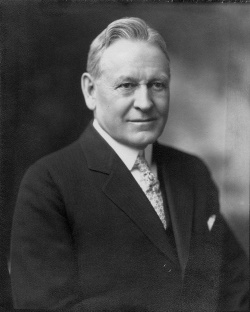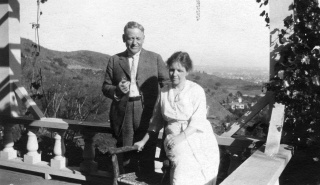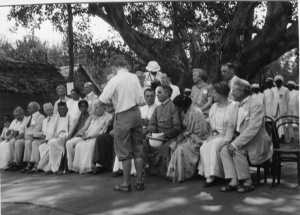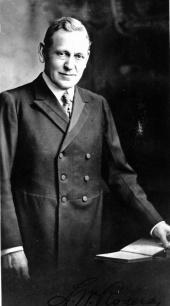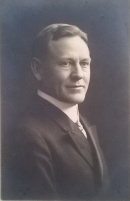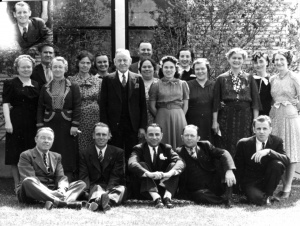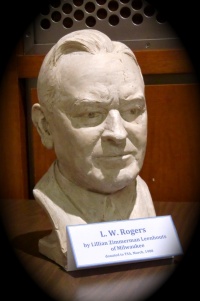L. W. Rogers: Difference between revisions
| (7 intermediate revisions by the same user not shown) | |||
| Line 12: | Line 12: | ||
Around 1907, Rogers married Fannie May Strong, always known as '''"May"''' or "Maysie." She was born on January 13, 1877 in Ferndale, California, as the daughter of Jacob H. Strong and Frances Walker Strong.<ref>U.S., Social Security Applications and Claims Index, 1936-2007. Application for May Strong Rogers.</ref><ref>Cook County, Illinois, Birth Certificates Index, 1871-1922. Birth certificate for Stanley.</ref> Son '''Stanley''' was born in Illinois on October 4, 1908, and son '''Grayson''' followed on October 13, 1910 in New York.<ref>1910 U. S. Census.</ref><ref>1940 U.S. WWII Draft Cards Young Men, 1940-1947.</ref> | Around 1907, Rogers married Fannie May Strong, always known as '''"May"''' or "Maysie." She was born on January 13, 1877 in Ferndale, California, as the daughter of Jacob H. Strong and Frances Walker Strong.<ref>U.S., Social Security Applications and Claims Index, 1936-2007. Application for May Strong Rogers.</ref><ref>Cook County, Illinois, Birth Certificates Index, 1871-1922. Birth certificate for Stanley.</ref> Son '''Stanley''' was born in Illinois on October 4, 1908, and son '''Grayson''' followed on October 13, 1910 in New York.<ref>1910 U. S. Census.</ref><ref>1940 U.S. WWII Draft Cards Young Men, 1940-1947.</ref> | ||
The family maintained a base in southern California, even though they traveled extensively on lecture tours. They owned a house at 2033 N. Argyle Avenue, in the Old Hollywood neighborhood of Los Angeles where the [[Krotona in Hollywood|Krotona colony]] had been established in 1911. During the early days of Krotona, L.W. was the Propaganda Manager, and May was editor of [[The Messenger (periodical)|''The Messenger,'']] the Society's journal. | The family maintained a base in southern California, even though they traveled extensively on lecture tours. They owned a house at 2033 N. Argyle Avenue, in the Old Hollywood neighborhood of Los Angeles where the [[Krotona in Hollywood|Krotona colony]] had been established in 1911. [[Charles Hampton]] was a neighbor at 2041 N. Argyle. During the early days of Krotona, L.W. was the Propaganda Manager, and May was editor of [[The Messenger (periodical)|''The Messenger,'']] the Society's journal. | ||
May lived in Hollywood with the boys most of the time. In 1930 she and her sons were living there with a woman boarder, and their next-door neighbor was artist and Theosophist [[Beatrice Wood]]. Stanley was working as a teacher in a private school and 19-year-old Grayson was not employed. L. W. was not present. When the census was taken, he was in the Wheaton, Illinois headquarters of the American Theosophical Society, or else on the road lecturing.<ref>1930 U. S. Census.</ref> By 1940, both sons were still living with their mother at Argyle Avenue. Stanley worked for the Francis Bacon Foundation, and Grayson at the R. K. O. Studio.<ref>1940 U. S. Census.</ref><ref>1940 U.S. WWII Draft Cards Young Men, 1940-1947.</ref> | May lived in Hollywood with the boys most of the time. In 1930 she and her sons were living there with a woman boarder, and their next-door neighbor was artist and Theosophist [[Beatrice Wood]]. Stanley was working as a teacher in a private school and 19-year-old Grayson was not employed. L. W. was not present. When the census was taken, he was in the Wheaton, Illinois headquarters of the American Theosophical Society, or else on the road lecturing.<ref>1930 U. S. Census.</ref> By 1940, both sons were still living with their mother at Argyle Avenue. Stanley worked for the Francis Bacon Foundation, and Grayson at the R. K. O. Studio.<ref>1940 U. S. Census.</ref><ref>1940 U.S. WWII Draft Cards Young Men, 1940-1947.</ref> | ||
| Line 38: | Line 38: | ||
== Theosophical Society activities == | == Theosophical Society activities == | ||
[[File:L W Rogers from MD TS.jpg|left|130px|thumb|L. W. Rogers]] | [[File:L W Rogers from MD TS.jpg|left|130px|thumb|L. W. Rogers]] | ||
In the 20th Century, Rogers' attention turned to spirituality, after '''Eugene V. Debs''' gave him a book about reincarnation.<ref>Joy Mills, ''100 Years of Theosophy in America'', Wheaton, Ill.: Theosophical Publishing House, 1987), 68.</ref>. In 1903 Rogers joined the [[American Theosophical Society]] during a course of lectures by [[Charles Webster Leadbeater]] in Los Angeles.<ref name=Quest>Robert Bonnell and Leatrice Kreeger-Bonnell, ''Quest'', 92:6 (Nov.-Dec. 2004), 224-226. Available at [ | In the 20th Century, Rogers' attention turned to spirituality, after '''Eugene V. Debs''' gave him a book about reincarnation.<ref>Joy Mills, ''100 Years of Theosophy in America'', Wheaton, Ill.: Theosophical Publishing House, 1987), 68.</ref>. In 1903 Rogers joined the [[American Theosophical Society]] during a course of lectures by [[Charles Webster Leadbeater]] in Los Angeles.<ref name=Quest>Robert Bonnell and Leatrice Kreeger-Bonnell, ''Quest'', 92:6 (Nov.-Dec. 2004), 224-226. Available at [https://www.theosophical.org/publications/quest-magazine/memories-of-l-w-rogers "Memories of L.W. Rogers,"].</ref><ref>"The New President" ''The Messenger'' 8.1 (June 1920), 446.</ref> He threw himself whole-heartedly into the Theosophical movement, lecturing extensively and publishing numerous books, articles, and pamphlets on [[Reincarnation|reincarnation]], life after death, [[Karma|karma]], and [[Dreams|dreams]], and other matters. A firebrand speaker, Rogers was much in demand as a lecturer. Within fifteen years he had organized 53 new lodges.<ref>""About the Candidates: L. W. Rogers," ''The American Theosophist" 33.4 (April, 1945), 86.</ref> | ||
From April, 1908 to October, 1909 he edited a periodical with the name [[The American Theosophist (periodical)|''American Theosophist'']], published in Albany, New York. | From April, 1908 to October, 1909 he edited a periodical with the name [[The American Theosophist (periodical)|''American Theosophist'']], published in Albany, New York. | ||
| Line 44: | Line 44: | ||
Over the course of many years, Mr. Rogers maintained a close association with [[Annie Besant]] and [[Charles Webster Leadbeater|C. W. Leadbeater]]. He made two '''world-wide lecture tours''' through Europe, the Far East, and Australia.<ref>""About the Candidates: L. W. Rogers," ''The American Theosophist" 33.4 (April, 1945), 86.</ref> | Over the course of many years, Mr. Rogers maintained a close association with [[Annie Besant]] and [[Charles Webster Leadbeater|C. W. Leadbeater]]. He made two '''world-wide lecture tours''' through Europe, the Far East, and Australia.<ref>""About the Candidates: L. W. Rogers," ''The American Theosophist" 33.4 (April, 1945), 86.</ref> | ||
Mr. Rogers’ granddaughter, Virginia Roach, commented on his strong friendship with [[Manly Palmer Hall|Manly Hall]], in an interview conducted by Robert and Leatrice Bonnell: “They were the closest of friends and spent many evenings exchanging views of lecturing locations pointed out on a world map spread before them. She also recalled the many Hall lectures, which L. W. enthusiastically attended.”<ref>Robert Bonnell and Leatrice Kreeger-Bonnell, "Memories of L. W. Rogers" ''The Quest'' 92.6 (November-December 2004), 224-226. Available at | Mr. Rogers’ granddaughter, Virginia Roach, commented on his strong friendship with '''[[Manly Palmer Hall|Manly Hall]]''', in an interview conducted by Robert and Leatrice Bonnell: “They were the closest of friends and spent many evenings exchanging views of lecturing locations pointed out on a world map spread before them. She also recalled the many Hall lectures, which L. W. enthusiastically attended.”<ref>Robert Bonnell and Leatrice Kreeger-Bonnell, "Memories of L. W. Rogers" ''The Quest'' 92.6 (November-December 2004), 224-226. Available at [https://www.theosophical.org/publications/quest-magazine/memories-of-l-w-rogers Quest website].</ref> | ||
[[File:LW Rogers in Casper WY 1940.jpg|right|300px|thumb|L. W. Rogers with members in Caspar, Wyoming, 1940.]] | [[File:LW Rogers in Casper WY 1940.jpg|right|300px|thumb|L. W. Rogers with members in Caspar, Wyoming, 1940.]] | ||
| Line 69: | Line 69: | ||
<blockquote> | <blockquote> | ||
Mr. Rogers and Grayson were on their way to Denver from St. Louis... when they struck an unexpected layer of loose sand, the car overturned and turned over at least twice on its way down an embankment. Mr. Rogers suffered a good many bruises and was badly shaken up, but a crushed finger was the only injury demanding hospital treatment. They were able to flag a train and get into Denver without too long delay, and Mr. Rogers kept his evening lecture engagement without allowing what he termed a rather disreputable appearance, to say nothing of a painful finger, to interfere.<ref>Anonymous, "Mr. Rogers' Accident" ''The American Theosophist 22.6 (June, 1934), 139.</ref> | Mr. Rogers and Grayson were on their way to Denver from St. Louis... when they struck an unexpected layer of loose sand, the car overturned and turned over at least twice on its way down an embankment. Mr. Rogers suffered a good many bruises and was badly shaken up, but a crushed finger was the only injury demanding hospital treatment. They were able to flag a train and get into Denver without too long delay, and Mr. Rogers kept his evening lecture engagement without allowing what he termed a rather disreputable appearance, to say nothing of a painful finger, to interfere.<ref>Anonymous, "Mr. Rogers' Accident" ''The American Theosophist 22.6 (June, 1934), 139.</ref> | ||
</blockquote> | |||
In 1936, Rogers took a year off: | |||
<blockquote> | |||
After over thirty years of itinerant Theosophical lecturing from September to May, Mr. Rogers tells us that he has decided to take a full year of rest and will do no public lecturing anywhere before the autumn of 1937.<ref>"Mr. Rogers," ''The American Theosophist'' 24 no.10 (Oct 1936), 236.</ref> | |||
</blockquote> | </blockquote> | ||
| Line 95: | Line 100: | ||
By 1925, the headquarters location in Chicago had become very overcrowded, and an initiative was undertaken to find a '''new permanent location'''. Rogers and his board wanted to stay in a central location within 500 miles of Chicago, and to create a campus where administrative activities could be conducted along with educational events and retreats. The National Secretary Kay Campbell found suitable land in Wheaton, Illinois that eventually became known as the [[Olcott (campus)|Olcott campus]]. Members donated and loaned money so that the headquarters building could be built, and operations were moved into it in September 1927. The headquarters structure was eventually renamed the [[L. W. Rogers Building]] in honor of the President who made it happen. | By 1925, the headquarters location in Chicago had become very overcrowded, and an initiative was undertaken to find a '''new permanent location'''. Rogers and his board wanted to stay in a central location within 500 miles of Chicago, and to create a campus where administrative activities could be conducted along with educational events and retreats. The National Secretary Kay Campbell found suitable land in Wheaton, Illinois that eventually became known as the [[Olcott (campus)|Olcott campus]]. Members donated and loaned money so that the headquarters building could be built, and operations were moved into it in September 1927. The headquarters structure was eventually renamed the [[L. W. Rogers Building]] in honor of the President who made it happen. | ||
Among the other accomplishments of the Rogers administration are these:<ref>Robert Bonnell and Leatrice Kreeger-Bonnell, "Memories of L. W. Rogers" ''The Quest'' 92.6 (November-December 2004), 224-226. Available at | Among the other accomplishments of the Rogers administration are these:<ref>Robert Bonnell and Leatrice Kreeger-Bonnell, "Memories of L. W. Rogers" ''The Quest'' 92.6 (November-December 2004), 224-226. Available at [https://www.theosophical.org/publications/quest-magazine/memories-of-l-w-rogers Quest website].</ref> | ||
* Increasing '''membership''' from 3,000 to over 8,000 members. | * Increasing '''membership''' from 3,000 to over 8,000 members. | ||
| Line 174: | Line 179: | ||
* '''''A World in Distress: the Remedy as Seen by the Theosophist''''' coauthored by C. Jinarājadāsa and Charles Leadbeater. | * '''''A World in Distress: the Remedy as Seen by the Theosophist''''' coauthored by C. Jinarājadāsa and Charles Leadbeater. | ||
== | == Additional resources== | ||
===Articles=== | ===Articles=== | ||
*[ | *[https://www.theosophical.org/publications/quest-magazine/memories-of-l-w-rogers Memories of L. W. Rogers] by Robert Bonnell and Leatrice Kreeger-Bonnell in ''The Quest'' Nov-Dec 2004. | ||
== Notes == | == Notes == | ||
| Line 191: | Line 196: | ||
[[Category:Imprisoned|Rogers, L. W.]] | [[Category:Imprisoned|Rogers, L. W.]] | ||
[[Category:TS Adyar|Rogers, L. W.]] | [[Category:TS Adyar|Rogers, L. W.]] | ||
[[Category:Krotona Hollywood|Rogers, L. W.]] | |||
[[Category:Co-Masons|Rogers, L. W.]] | |||
[[Category:People|Rogers, L. W.]] | [[Category:People|Rogers, L. W.]] | ||
Latest revision as of 19:32, 11 January 2024
Louis William Rogers (May 28, 1859 - April 18, 1953) was an American lecturer and editor who served from 1920 to 1931 as General Secretary and President of the American Theosophical Society in the Theosophical Society based in Adyar. A man of great energy and vision, who organized dozens of lodges in the United States, he was always known as "L. W."
Personal life
Louis William Rogers was born in Benton, Linn County, Iowa on May 28, 1859. He attended college, then taught in the public schools of Iowa and Kansas for five years, beginning late in the 1870s.[1] In the 1880s Rogers became a public lecturer in the Free Thought movement, which had Rationalism as its underlying philosophy. After a career as a union organizer and journalist, he became involved in the American Theosophical Society, to which he devoted the rest of his life.
Marriage and children
Around 1907, Rogers married Fannie May Strong, always known as "May" or "Maysie." She was born on January 13, 1877 in Ferndale, California, as the daughter of Jacob H. Strong and Frances Walker Strong.[2][3] Son Stanley was born in Illinois on October 4, 1908, and son Grayson followed on October 13, 1910 in New York.[4][5]
The family maintained a base in southern California, even though they traveled extensively on lecture tours. They owned a house at 2033 N. Argyle Avenue, in the Old Hollywood neighborhood of Los Angeles where the Krotona colony had been established in 1911. Charles Hampton was a neighbor at 2041 N. Argyle. During the early days of Krotona, L.W. was the Propaganda Manager, and May was editor of The Messenger, the Society's journal.
May lived in Hollywood with the boys most of the time. In 1930 she and her sons were living there with a woman boarder, and their next-door neighbor was artist and Theosophist Beatrice Wood. Stanley was working as a teacher in a private school and 19-year-old Grayson was not employed. L. W. was not present. When the census was taken, he was in the Wheaton, Illinois headquarters of the American Theosophical Society, or else on the road lecturing.[6] By 1940, both sons were still living with their mother at Argyle Avenue. Stanley worked for the Francis Bacon Foundation, and Grayson at the R. K. O. Studio.[7][8]
May Rogers was very active in the Theosophical Society. She accompanied her husband on many of his lecture tours, including two long visits to Australia. After L. W. had stirred up interest in a new location with his rousing public lectures, Maysie would teach a beginning class in Theosophy for two weeks, so that a new lodge could be left well-established. During the war years, she headed the Red Cross relief efforts; played music at Krotona concerts and Liberal Catholic Church services; served for a time as secretary to Annie Besant in Adyar in 1929; and was Vice President of the Southern California Federation. Mrs. Rogers was much loved by her coworkers: "She is everything that is loving, joyous, and beautiful, as well as gifted and capable."[9]
Sons Grayson and Stanley were also involved with the Society. In 1926 George S. Arundale, then General Secretary of the Australian Section, wrote that "We are indeed blessed with Mr. Stanley Rogers, a printing expert, the son of the American General Secretary and of Mrs. Rogers. What we should do without him I do not know."[10] Stanley worked in the printing department of Advance! Australia.[11]
May survived her husband by thirteen years. She passed away on April 15, 1966 in Ojai, California.[12]
Railroad career and union activities
Rogers began a railroad career with a job as a brakeman, "when fresh from college," and went on to edit a series of periodicals related to railroads and the hazardous conditions of their union workers.[13] In 1888 Rogers launched a short-lived newspaper, the Railroad Patriot of St. Joseph, Missouri.[1] The next year, he moved to Colorado, where he became active first in the Brotherhood of Railroad Brakemen and then in the Brotherhood of Railroad Trainmen.[1] From 1889 to 1892 he edited several periodicals - the Railroad Brakemen's Journal, the Denver Patriot, and the Vona Herald. Early in the 1890s Rogers returned to the Midwest, moving first to the rail hub of Galesburg, Illinois, then to Chicago, and finally in 1892 to Oshkosh, Wisconsin. He published a new paper, the Age of Labor, which merged in 1893 with The Labor Advocate, a prominent labor newspaper of the day.[1] That year he helped to establish the Wisconsin Federation of Labor.[1] During this period he also fought for "child labor laws in the factories, and was a co-worker with Florence Kelly and Jane Addams of Hull House fame."[14]
American Railway Union activities
In 1894, former Brotherhood of Locomotive Firemen official Eugene V. Debs established the American Railway Union (ARU), attempting to create an industrial union that joined all the railway workers in a powerful, centralized organization. Rogers became a member of the ARU's executive board, and was appointed editor of the organization's weekly newspaper, Railway Times.[1] In 1894, the United States Attorney General responded to the ARU's famous Pullman Strike by issuing an injunction ordering the union to cease striking against any train carrying U.S. Mail.[15] L. W. Rogers, Eugene V. Debs, and two other union officials were found to be in contempt of the injunction, and they surrendered to authorities on July 17, 1894. Bail was set at $3,000 each, and all four ARU officials waived the right to post bail. They were immediately taken to Cook County Jail. Rogers later recalled that the substantial amount set for bail was not the cause of the decision to waive bail, declaring, "If it was $2, I'd go to jail. This is a mighty test between labor and capital, and we will fight it to the finish."[16] The four were released on July 25.[17] After a trial, the union and its leaders were found guilty of having conducted an illegal strike in violation of the Sherman Anti-Trust Act.[18] Rogers was sentenced to three months to be served in McHenry County Jail, which was served from June to August, 1895.[19] Debs and the union were subjected to further charges in a case that was defended all the way to the U. S. Supreme Court by the famous orator Clarence Darrow, although the unionists ultimately lost.
Later activities in unions and journalism
Rogers moved to Pueblo, Colorado, where he worked as an organizer for the American Federation of Labor, and edited another labor newspaper in 1896, the Industrial Advocate.[1] He was sent by the Denver News "as special correspondent to the mining camps of the Rocky mountains, in the era when pistols and knives were relied upon to settle arguments."In 1897 he returned to Chicago to edit The Social Democrat, the journal of Eugene V. Debs' new political party, the Social Democratic Party of America. He also helped to organize Debs' lecture tours for two years.[1] He remained involved with the labor movement, serving as President of the Michigan Federation of Labor from 1898 to 1899.[1]
Theosophical Society activities
In the 20th Century, Rogers' attention turned to spirituality, after Eugene V. Debs gave him a book about reincarnation.[20]. In 1903 Rogers joined the American Theosophical Society during a course of lectures by Charles Webster Leadbeater in Los Angeles.[21][22] He threw himself whole-heartedly into the Theosophical movement, lecturing extensively and publishing numerous books, articles, and pamphlets on reincarnation, life after death, karma, and dreams, and other matters. A firebrand speaker, Rogers was much in demand as a lecturer. Within fifteen years he had organized 53 new lodges.[23]
From April, 1908 to October, 1909 he edited a periodical with the name American Theosophist, published in Albany, New York.
Over the course of many years, Mr. Rogers maintained a close association with Annie Besant and C. W. Leadbeater. He made two world-wide lecture tours through Europe, the Far East, and Australia.[24]
Mr. Rogers’ granddaughter, Virginia Roach, commented on his strong friendship with Manly Hall, in an interview conducted by Robert and Leatrice Bonnell: “They were the closest of friends and spent many evenings exchanging views of lecturing locations pointed out on a world map spread before them. She also recalled the many Hall lectures, which L. W. enthusiastically attended.”[25]
Lecture tours
THIS SECTION UNDER CONSTRUCTION
THIS SECTION UNDER CONSTRUCTION
Both as a union organizer and as a Theosophical worker, Mr. Rogers was known for his great skill in lecturing. He delivered thousands of lectures, and is credited with establishing fifty lodges during the years 1905-1920.[26] Here are some examples of lecture tours:
1912 tour
1918 Australian tour
In 1918 Mr. Rogers toured Australia as a lecturer, where large audiences heard him nightly in Sydney.[27] Irving S. Cooper was also in Sydney, assisting Charles Webster Leadbeater with matters related to the Liberal Catholic Church and occult properties of its mass. Cooper was well known to Rogers, having boarded with the Rogers family in 1910 in New Jersey. Mrs. Rogers also traveled separately to Australia with her young sons, who were then 7 and 9 years old. She wrote an account of her activities to The Messenger:
The particular task in which is just now her privilege and great joy to be engaged, is that of assisting Mr. Leadbeater in the preparation of several new Theosophical text-books. She is very, very busy and wonderfully happy over her great opportunity. When she returns to America, it will be with renewed inspiration and increased powers for helping the cause of Theosophy.[28]
Challenges of touring
An incident in 1934 illustrates the challenges of cross-country lecture tours:
Mr. Rogers and Grayson were on their way to Denver from St. Louis... when they struck an unexpected layer of loose sand, the car overturned and turned over at least twice on its way down an embankment. Mr. Rogers suffered a good many bruises and was badly shaken up, but a crushed finger was the only injury demanding hospital treatment. They were able to flag a train and get into Denver without too long delay, and Mr. Rogers kept his evening lecture engagement without allowing what he termed a rather disreputable appearance, to say nothing of a painful finger, to interfere.[29]
In 1936, Rogers took a year off:
After over thirty years of itinerant Theosophical lecturing from September to May, Mr. Rogers tells us that he has decided to take a full year of rest and will do no public lecturing anywhere before the autumn of 1937.[30]
In November, 1942, "due to a bad cold acquired on an overheated sleeper, Mr. Rogers has been in a hospital in Spokane with a mild case of pneumonia." He had to cancel the remainder of the tour and return to his home in Los Angeles to rest. He was then 82 years old.[31]
Vice President and Acting President
He was elected Vice President in 1918 during the administration of A. P. Warrington. For nearly a year of his term, Rogers was assisting the Australian Section as a visiting lecturer, but the tour was cut short due to influenza. He was welcomed back to Krotona in mid-1919.[32] He lectured in Nevada and all along the Pacific coast.[33]In August he proceeded to Alaska, where no Theosophical lecturer had ventured before, and then went on to Winnipeg.[34] During travels to remote locations, Rogers was always the journalist. He regularly sent back riveting travelogues of the places he visited – the weather, people, customs, geography, schools, and economy – and always the prospects for forming Theosophical lodges.
1920 Convention
THIS SECTION UNDER CONSTRUCTION
THIS SECTION UNDER CONSTRUCTION
On March 18, 1920, A. P. Warrington addressed a letter to the Trustees of the Section, announcing his resignation.[35] The annual convention that year was turbulent, but ultimately, Rogers was elected as President (General Secretary) of the Section.
President of the American Theosophical Society
His first actions as President were decisive. Within a month, he changed the venue for the Thirty-Fourth Annual Convention from Seattle to Chicago. The National Secretary, Foster Bailey, was replaced by Mrs. Betsey Jewett. At the same time, Rogers removed the editor of the Society's periodical, The Messenger, Alice Evans, who later became Alice Bailey. Mrs. Grace Boughton Voce became Editor. Woodruff Sheppard, the Publicity Director, was removed from his position, and Bruno Ussher temporarily took over.[36]
In May he published a statement of policy that he had promised to the membership. While the American Theosophical Society was sound financially, its affairs were complicated by the economic disarray of the Krotona Institute of Theosophy. Ultimately the property in Hollywood was sold. The Esoteric Section moved to Ojai, California, and Rogers moved headquarters operations back to Chicago, which he considered to be more suitable due to its central location. The Theosophical Book Concern was re-established to increase publication and distribution of Theosophical books. His plan was to emphasize publishing as a major activity of the national organization, and to strengthen the local groups with national lecturers. In 1920 alone, he opened 55 branches of the Society. A tireless organizer, he continually lectured all over the country.
By 1925, the headquarters location in Chicago had become very overcrowded, and an initiative was undertaken to find a new permanent location. Rogers and his board wanted to stay in a central location within 500 miles of Chicago, and to create a campus where administrative activities could be conducted along with educational events and retreats. The National Secretary Kay Campbell found suitable land in Wheaton, Illinois that eventually became known as the Olcott campus. Members donated and loaned money so that the headquarters building could be built, and operations were moved into it in September 1927. The headquarters structure was eventually renamed the L. W. Rogers Building in honor of the President who made it happen.
Among the other accomplishments of the Rogers administration are these:[37]
- Increasing membership from 3,000 to over 8,000 members.
- Increasing the number of lodges from 100 to 209.
- Founding the Theosophical Book Gift Institute.
- Revising the national by-laws to a more democratic platform.
- Founding the Messenger newsletter.
- Encouraging vegetarianism for establishing a Vegetarian Cooking Club.
- Establishing a Purchasing Service Bureau managed by Dr. Ernest Stone to sell hard-to-find foods and other items to members.
Later years
Sidney A. Cook took over as president in 1931. During the years after his presidency, Mr. Rogers continued to lecture around the country on behalf of the Society. In 1931 Mr. Rogers reported that 48 new members joined the St. Louis Lodge after a week of lectures, and regarded that as "the largest number ever obtained during a single week by one Lodge in his entire experience of 28 years."[38] Another spectacular success in his later years of lecturing came when he toured Mexico in 1939: "Inspired by the leadership of Mr. L. W. Rogers, thirty-eight members in Mexico City have joined hands in a new lodge for the spreading of Theosophy in Mexico. Mr. Rogers writes that thirty-six of these members are entirely new to the Society."[39]
In order to reach southern and eastern locations more easily, Rogers moved in 1944 from California to St. Petersburg, Florida, but in 1947 at age 88 he announced his retirement from the lecture circuit.
Instead he undertook expansion of the Theosophical Book Gift Institute. In the first year he and Mrs. Lillian Carr of Paterson Lodge (New Jersey) placed 5-6 books in each of 502 institutions - 254 public libraries, plus academic libraries, and collections in hospitals, naval bases, and prisons.[40]
The organization incorporated as an Illinois not-for-profit corporation in 1948. At the passing of Eugene Wix, who initially served as secretary-treasurer, Mr. Rogers took on the position of secretary, and Herbert A. Kern, Sr. became the treasurer. Rogers wrote,
Mr. Kern is not only a long-time member of The Theosophical Society but is a man with very wide business experience. T. G. B. I. is indeed fortunate to have him on its working staff.
With this improvement in its working force T. G. B. I. will carry on the work with renewed energy. Its past work has scattered thousands of theosophical books over the nation; and they are now available to readers in scores of universities, colleges, public libraries, hospitals, on the ships of the United States Navy and in military camps and training stations. [41]
Louis Rogers died in Santa Barbara, California, on April 18, 1953.[42]
Editorial work
UNDER CONSTRUCTION
UNDER CONSTRUCTION
Rogers served as the editor of two of the Society's other periodicals — Ancient Wisdom, which he edited from 1935 to 1936, and The Voice, beginning in 1952.
Writings about Theosophy
Mr. Rogers wrote hundreds of columns and articles for The Messenger, The Theosophic Messenger, The American Theosophist, The Theosophist, Discovery, and other periodicals. They are listed in the Union Index of Theosophical Periodicals under the names "LW Rogers", "L W Rogers", and LWR. In 1949, Mr. Rogers was awarded the Subba Row Medal for his contributions to Theosophical literature.
These are some of his numerous books and pamphlets, listed in order of publication:
- The Evidence for Theosophy: A Lecture. Harrogate: Theosophical Publishing Committee, 1906.
- The Occultism in Shakespeare's Plays. New York: Theosophical Book Co., 1909. Available at Internet Archive and Hathitrust.
- Occultism as a Factor in Civilization: A Lecture on the Two Phases of Human Evolution Represented in the Civilization of the Occident and the Orient. Ridgewood, NJ: Theosophical Book Company, 1910.
- The Hidden Side of Evolution: A Lecture on the Reasonableness of the Existence of a Spiritual Hierarchy and the Guidance of Human Evolution. Chicago: L.W. Rogers, n.d. [c. 1910s].
- What Theosophy Is. Chicago: National Publicity Department, Theosophical Society, 1910.
- Soul Powers and Possibilities: A Lecture on Some of the Methods by which those powers that are latent in all human beings may be evolved. Ridgewood, N.J.: Theosophical Book Co., 1910.
- Karma: Nature's Law of Justice: A Lecture on the Law of Cause and Effect as Operating in Some of the Affairs of Love. Los Angeles: Theosophical Book Concern, n.d. [c. 1910s].
- Hints to Young Students of Occultism.
- 3rd Edition - Ridgewood, N.J.: The Theosophical Book Co., 1911. Available at Hathitrust.
- 4th Edition - Los Angeles: Theosophical Book Concern, 1917. Available at [Available at Hathitrust and another Hathitrust version.
- Chicago: Theosophical Theosophical Concern, 1931.
- The Inspired Life. Los Angeles: L.W. Rogers, 1915.
- Self Development and the Way to Power. Los Angeles: L.W. Rogers, 1916. Available at Overdrive Content Reserve and Hathitrust.
- Elementary Theosophy. Los Angeles: Theosophical Book Concern, 1917. Seven more edition by Theosophical Press and Theosophical Publishing House, Wheaton, Illinois. 1917 edition available online at Internet Archive and Hathitrust.
- The Life Sublime. Chicago: Theosophical Book Concern, 1917.
- Reincarnation from the Scientific Viewpoint: A Lecture Chicago: Theosophical Book Concern, 1917.
- Reincarnation: Do We Live on Earth Again? Chicago: National Publicity Dept., Theosophical Society, 1917.
- The Logic of Reincarnation: A Lecture. Chicago: Theosophical Book Co., 1918.
- Beyond the Border: A Lecture. Chicago: Theosophical Book Co., 1918.
- Occultism as a Factor in Civilization: A Lecture. Chicago: Theosophical Book Concern, 1918.
- Scientific Evidence of Future Life: A Lecture. Chicago: Theosophical Book Concern, 1918.
- The Invisible World About Us: A Lecture on the Unseen Regions Beyond the Grasp of the Physical Senses and the Life We Live After Bodily Death. Chicago: Theosophical Book Concern, 1918. Available at Hathitrust.
- Australian War Speeches and the Soldier Dead. Chicago: Theosophical Book Concern, c. 1918.
- Dreams and Premonitions. Chicago: Theosophical Book Concern, 1923 and Wheaton, Ill.: The Theosophical Press, 1948.
- Theosophical Questions Answered. Chicago: Theosophical Book Concern, 1924.
- Gods in the Making, and Other Lectures. Chicago: Theosophical Book Concern, 1925. Republished in 1950 as Man: An Embryo God, and Other Lectures.
- The Purpose of Life, and Other Lectures. Chicago: Theosophical Book Concern, 1925.
- The Soldier Dead; and A Scientific Religion. Chicago: Theosophical Book Concern, 1925.
- Universal Brotherhood. Chicago: Theosophical Concern, 1925.
- The Coming Civilization. Chicago: Theosophical Book Concern, 1934.
- Olcott Manual: First Series: Theosophy, Religion, Science, Philosophy. With Annie Besant. Wheaton, IL: Theosophical Press, 1934.
- Reincarnation, and Other Lectures. Wheaton, IL: Theosophical Press, n.d. [1940s].
- The Ghosts in Shakespeare: A Study of the Occultism in the Shakespeare Plays. Wheaton, IL: Theosophical Press, 1949 and 1955; New York, Haskell House Publishers, 1972; and Folcroft, Pa.: Folcroft Library Editions, 1973. First edition was in 1925.
- Man: An Embryo God, and Other Lectures. Wheaton, IL: Theosophical Press, 1950. Published in 1925 as Gods in the Making.
- Karma: The Law of Human Destiny. New York: Philosophers Book Shop, n.d.
- A World in Distress: the Remedy as Seen by the Theosophist coauthored by C. Jinarājadāsa and Charles Leadbeater.
Additional resources
Articles
- Memories of L. W. Rogers by Robert Bonnell and Leatrice Kreeger-Bonnell in The Quest Nov-Dec 2004.
Notes
- ↑ 1.0 1.1 1.2 1.3 1.4 1.5 1.6 1.7 1.8 Stuart B. Kaufman, Peter J. Albert, and Grace Palladino (eds.), The Samuel Gompers Papers: Volume 4: A National Labor Movement Takes Shape, 1895-98, (Urbana, IL: Illinois University Press, 1991), 547-548.
- ↑ U.S., Social Security Applications and Claims Index, 1936-2007. Application for May Strong Rogers.
- ↑ Cook County, Illinois, Birth Certificates Index, 1871-1922. Birth certificate for Stanley.
- ↑ 1910 U. S. Census.
- ↑ 1940 U.S. WWII Draft Cards Young Men, 1940-1947.
- ↑ 1930 U. S. Census.
- ↑ 1940 U. S. Census.
- ↑ 1940 U.S. WWII Draft Cards Young Men, 1940-1947.
- ↑ "Editor Visits Australia" The Messenger 6.1 (June 1918), 841.
- ↑ "News Items" The Messenger 14.3 (August 1926), 65.
- ↑ "News Items" The Messenger 14.8 (Jan 1927), 180.
- ↑ U.S., Social Security Death Index, 1935-2014.
- ↑ "The New President" The Messenger 8.1 (June 1920), 446. This article was derived from a sketch by Bruno Ussher.
- ↑ "The New President" The Messenger 8.1 (June 1920), 446.
- ↑ David Ray Papke, The Pullman Case: The Clash of Labor and Capital in Industrial America., (Lawrence, KS: University Press of Kansas, 1999), 40.
- ↑ Quoted in Papke, The Pullman Case, 44.
- ↑ J. Robert Constantine (ed.), Letters of Eugene V. Debs: Volume 1, 1874-1912, (Urbana, IL: Illinois University Press, 1990), 72.
- ↑ Papke, The Pullman Case, pp. 49-50.
- ↑ Constantine (ed.), Letters of Eugene V. Debs: Vol. 1, pg. 98, fn. 9.
- ↑ Joy Mills, 100 Years of Theosophy in America, Wheaton, Ill.: Theosophical Publishing House, 1987), 68.
- ↑ Robert Bonnell and Leatrice Kreeger-Bonnell, Quest, 92:6 (Nov.-Dec. 2004), 224-226. Available at "Memories of L.W. Rogers,".
- ↑ "The New President" The Messenger 8.1 (June 1920), 446.
- ↑ ""About the Candidates: L. W. Rogers," The American Theosophist" 33.4 (April, 1945), 86.
- ↑ ""About the Candidates: L. W. Rogers," The American Theosophist" 33.4 (April, 1945), 86.
- ↑ Robert Bonnell and Leatrice Kreeger-Bonnell, "Memories of L. W. Rogers" The Quest 92.6 (November-December 2004), 224-226. Available at Quest website.
- ↑ "Convention Tribute to Mr. Rogers" The American Theosophist 25.9 (September 1937), 214.
- ↑ "Mr. Cooper and Mr. Rogers" The Messenger 6.4 (September 1918), 119.
- ↑ "News from Mrs. Rogers" The Messenger 6.4 (September 1918), 119.
- ↑ Anonymous, "Mr. Rogers' Accident" The American Theosophist 22.6 (June, 1934), 139.
- ↑ "Mr. Rogers," The American Theosophist 24 no.10 (Oct 1936), 236.
- ↑ "Mr. Rogers Cancels" The American Theosophist 30.11 (Nov 1942), 261.
- ↑ "Mr. Rogers Returns" The Messenger 6.12 (May, 1919), 367.
- ↑ L. W. Rogers, "From Mr. Rogers" The Messenger 7.3 (August, 1919), 87-88.
- ↑ L. W. Rogers, "Organizing the Northland" The Messenger 7.3 (August, 1919), 74-75.
- ↑ The Messenger (April, 1920) ????????.
- ↑ Mills, 68-69.
- ↑ Robert Bonnell and Leatrice Kreeger-Bonnell, "Memories of L. W. Rogers" The Quest 92.6 (November-December 2004), 224-226. Available at Quest website.
- ↑ "What Lodges Are Doing" The Theosophical Messenger 19.5 (May, 1931), 402.
- ↑ "New Lodge In Mexico, " The American Theosophist 27. 10 (October, 1939), 239.
- ↑ L. W. Rogers, "Theosophical Book Gift Institute in 1947" The American Theosophist 35.1 (January, 1947), 17-18.
- ↑ "T. G. B. I. Affairs," The American Theosophist 36.5 (May, 1948), 119.
- ↑ State of California. California Death Index, 1940-1997. Sacramento, CA, USA: State of California Department of Health Services, Center for Health Statistics. California, Death Index, 1940-1997.
